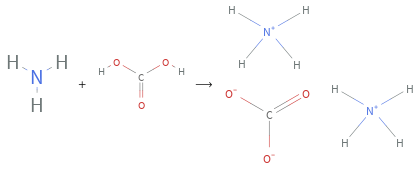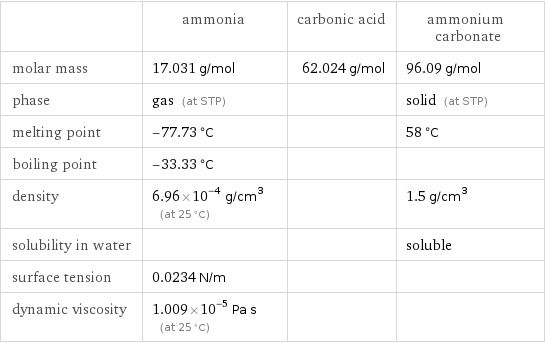Input interpretation

NH_3 ammonia + H_2CO_3 carbonic acid ⟶ (NH_4)_2CO_3 ammonium carbonate
Balanced equation

Balance the chemical equation algebraically: NH_3 + H_2CO_3 ⟶ (NH_4)_2CO_3 Add stoichiometric coefficients, c_i, to the reactants and products: c_1 NH_3 + c_2 H_2CO_3 ⟶ c_3 (NH_4)_2CO_3 Set the number of atoms in the reactants equal to the number of atoms in the products for H, N, C and O: H: | 3 c_1 + 2 c_2 = 8 c_3 N: | c_1 = 2 c_3 C: | c_2 = c_3 O: | 3 c_2 = 3 c_3 Since the coefficients are relative quantities and underdetermined, choose a coefficient to set arbitrarily. To keep the coefficients small, the arbitrary value is ordinarily one. For instance, set c_2 = 1 and solve the system of equations for the remaining coefficients: c_1 = 2 c_2 = 1 c_3 = 1 Substitute the coefficients into the chemical reaction to obtain the balanced equation: Answer: | | 2 NH_3 + H_2CO_3 ⟶ (NH_4)_2CO_3
Structures

+ ⟶
Names

ammonia + carbonic acid ⟶ ammonium carbonate
Equilibrium constant
![Construct the equilibrium constant, K, expression for: NH_3 + H_2CO_3 ⟶ (NH_4)_2CO_3 Plan: • Balance the chemical equation. • Determine the stoichiometric numbers. • Assemble the activity expression for each chemical species. • Use the activity expressions to build the equilibrium constant expression. Write the balanced chemical equation: 2 NH_3 + H_2CO_3 ⟶ (NH_4)_2CO_3 Assign stoichiometric numbers, ν_i, using the stoichiometric coefficients, c_i, from the balanced chemical equation in the following manner: ν_i = -c_i for reactants and ν_i = c_i for products: chemical species | c_i | ν_i NH_3 | 2 | -2 H_2CO_3 | 1 | -1 (NH_4)_2CO_3 | 1 | 1 Assemble the activity expressions accounting for the state of matter and ν_i: chemical species | c_i | ν_i | activity expression NH_3 | 2 | -2 | ([NH3])^(-2) H_2CO_3 | 1 | -1 | ([H2CO3])^(-1) (NH_4)_2CO_3 | 1 | 1 | [(NH4)2CO3] The equilibrium constant symbol in the concentration basis is: K_c Mulitply the activity expressions to arrive at the K_c expression: Answer: | | K_c = ([NH3])^(-2) ([H2CO3])^(-1) [(NH4)2CO3] = ([(NH4)2CO3])/(([NH3])^2 [H2CO3])](../image_source/1fc662e9d1ef9e9bde86fef9ee11b711.png)
Construct the equilibrium constant, K, expression for: NH_3 + H_2CO_3 ⟶ (NH_4)_2CO_3 Plan: • Balance the chemical equation. • Determine the stoichiometric numbers. • Assemble the activity expression for each chemical species. • Use the activity expressions to build the equilibrium constant expression. Write the balanced chemical equation: 2 NH_3 + H_2CO_3 ⟶ (NH_4)_2CO_3 Assign stoichiometric numbers, ν_i, using the stoichiometric coefficients, c_i, from the balanced chemical equation in the following manner: ν_i = -c_i for reactants and ν_i = c_i for products: chemical species | c_i | ν_i NH_3 | 2 | -2 H_2CO_3 | 1 | -1 (NH_4)_2CO_3 | 1 | 1 Assemble the activity expressions accounting for the state of matter and ν_i: chemical species | c_i | ν_i | activity expression NH_3 | 2 | -2 | ([NH3])^(-2) H_2CO_3 | 1 | -1 | ([H2CO3])^(-1) (NH_4)_2CO_3 | 1 | 1 | [(NH4)2CO3] The equilibrium constant symbol in the concentration basis is: K_c Mulitply the activity expressions to arrive at the K_c expression: Answer: | | K_c = ([NH3])^(-2) ([H2CO3])^(-1) [(NH4)2CO3] = ([(NH4)2CO3])/(([NH3])^2 [H2CO3])
Rate of reaction
![Construct the rate of reaction expression for: NH_3 + H_2CO_3 ⟶ (NH_4)_2CO_3 Plan: • Balance the chemical equation. • Determine the stoichiometric numbers. • Assemble the rate term for each chemical species. • Write the rate of reaction expression. Write the balanced chemical equation: 2 NH_3 + H_2CO_3 ⟶ (NH_4)_2CO_3 Assign stoichiometric numbers, ν_i, using the stoichiometric coefficients, c_i, from the balanced chemical equation in the following manner: ν_i = -c_i for reactants and ν_i = c_i for products: chemical species | c_i | ν_i NH_3 | 2 | -2 H_2CO_3 | 1 | -1 (NH_4)_2CO_3 | 1 | 1 The rate term for each chemical species, B_i, is 1/ν_i(Δ[B_i])/(Δt) where [B_i] is the amount concentration and t is time: chemical species | c_i | ν_i | rate term NH_3 | 2 | -2 | -1/2 (Δ[NH3])/(Δt) H_2CO_3 | 1 | -1 | -(Δ[H2CO3])/(Δt) (NH_4)_2CO_3 | 1 | 1 | (Δ[(NH4)2CO3])/(Δt) (for infinitesimal rate of change, replace Δ with d) Set the rate terms equal to each other to arrive at the rate expression: Answer: | | rate = -1/2 (Δ[NH3])/(Δt) = -(Δ[H2CO3])/(Δt) = (Δ[(NH4)2CO3])/(Δt) (assuming constant volume and no accumulation of intermediates or side products)](../image_source/143a09a99a93af24bd0304af421a4d46.png)
Construct the rate of reaction expression for: NH_3 + H_2CO_3 ⟶ (NH_4)_2CO_3 Plan: • Balance the chemical equation. • Determine the stoichiometric numbers. • Assemble the rate term for each chemical species. • Write the rate of reaction expression. Write the balanced chemical equation: 2 NH_3 + H_2CO_3 ⟶ (NH_4)_2CO_3 Assign stoichiometric numbers, ν_i, using the stoichiometric coefficients, c_i, from the balanced chemical equation in the following manner: ν_i = -c_i for reactants and ν_i = c_i for products: chemical species | c_i | ν_i NH_3 | 2 | -2 H_2CO_3 | 1 | -1 (NH_4)_2CO_3 | 1 | 1 The rate term for each chemical species, B_i, is 1/ν_i(Δ[B_i])/(Δt) where [B_i] is the amount concentration and t is time: chemical species | c_i | ν_i | rate term NH_3 | 2 | -2 | -1/2 (Δ[NH3])/(Δt) H_2CO_3 | 1 | -1 | -(Δ[H2CO3])/(Δt) (NH_4)_2CO_3 | 1 | 1 | (Δ[(NH4)2CO3])/(Δt) (for infinitesimal rate of change, replace Δ with d) Set the rate terms equal to each other to arrive at the rate expression: Answer: | | rate = -1/2 (Δ[NH3])/(Δt) = -(Δ[H2CO3])/(Δt) = (Δ[(NH4)2CO3])/(Δt) (assuming constant volume and no accumulation of intermediates or side products)
Chemical names and formulas

| ammonia | carbonic acid | ammonium carbonate formula | NH_3 | H_2CO_3 | (NH_4)_2CO_3 Hill formula | H_3N | CH_2O_3 | CH_8N_2O_3 name | ammonia | carbonic acid | ammonium carbonate
Substance properties

| ammonia | carbonic acid | ammonium carbonate molar mass | 17.031 g/mol | 62.024 g/mol | 96.09 g/mol phase | gas (at STP) | | solid (at STP) melting point | -77.73 °C | | 58 °C boiling point | -33.33 °C | | density | 6.96×10^-4 g/cm^3 (at 25 °C) | | 1.5 g/cm^3 solubility in water | | | soluble surface tension | 0.0234 N/m | | dynamic viscosity | 1.009×10^-5 Pa s (at 25 °C) | |
Units
